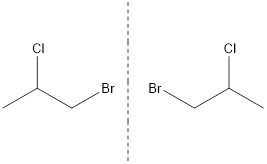
a.
Interpretation:
The structure of 1-bromo-2-chloroproapane needs to be drawn.
Concept introduction:
The organic compounds generally contain carbon atoms. The naming of organic compounds is done by considering three main terms which are prefix, suffix and the root name. The longest chain in the compound is first identified and named that will be the root name for the compound. For example, if there are 3 carbon atoms in the longest chain, the root name will be “prop”. To determine the suffix,
a.
Explanation of Solution
The given formula is 1-bromo-2-chloropropane.
From the name it can be seen that there are 3 carbon atoms in the chain. Also, there is 1 bromine atom and 1 chlorine atom at 1st and 2nd position respectively.
Thus, the structure of compound will be:

b.
Interpretation:
Whether the compound has optical isomers or not needs to be determined.
Concept introduction:
If there are same number of atoms in two compounds but the arrangement is different also, the structure of two compounds are non-superimposable mirror images of each other, they are termed as optical isomers.
b.
Explanation of Solution
When two compounds contain same number of atoms and bonds but different spatial arrangements of atoms with non-superimposable mirror images, then they are known as optical isomers.
The non-superimposable mirror images are known as enantiomer.
The mirror image of the given compound is represented as follows:

Thus, the compound has optical isomer.
c.
Interpretation:
The chiral carbon atom needs to be identified.
Concept introduction:
The chiral center has 4 different groups attached to carbon atom.
c.
Explanation of Solution
The given compound is as follows:

Here, the carbon atom which is attached to 4 different groups is chiral carbon. This is represented as follows:

Thus, the chiral center is represented in the structure of the compound.
Chapter 22 Solutions
Chemistry: Matter and Change
Additional Science Textbook Solutions
Introductory Chemistry (5th Edition) (Standalone Book)
General, Organic, and Biological Chemistry (3rd Edition)
Chemistry: The Central Science (14th Edition)
Chemistry: Structure and Properties
Inorganic Chemistry
Chemistry: The Central Science (13th Edition)
 ChemistryChemistryISBN:9781305957404Author:Steven S. Zumdahl, Susan A. Zumdahl, Donald J. DeCostePublisher:Cengage Learning
ChemistryChemistryISBN:9781305957404Author:Steven S. Zumdahl, Susan A. Zumdahl, Donald J. DeCostePublisher:Cengage Learning ChemistryChemistryISBN:9781259911156Author:Raymond Chang Dr., Jason Overby ProfessorPublisher:McGraw-Hill Education
ChemistryChemistryISBN:9781259911156Author:Raymond Chang Dr., Jason Overby ProfessorPublisher:McGraw-Hill Education Principles of Instrumental AnalysisChemistryISBN:9781305577213Author:Douglas A. Skoog, F. James Holler, Stanley R. CrouchPublisher:Cengage Learning
Principles of Instrumental AnalysisChemistryISBN:9781305577213Author:Douglas A. Skoog, F. James Holler, Stanley R. CrouchPublisher:Cengage Learning Organic ChemistryChemistryISBN:9780078021558Author:Janice Gorzynski Smith Dr.Publisher:McGraw-Hill Education
Organic ChemistryChemistryISBN:9780078021558Author:Janice Gorzynski Smith Dr.Publisher:McGraw-Hill Education Chemistry: Principles and ReactionsChemistryISBN:9781305079373Author:William L. Masterton, Cecile N. HurleyPublisher:Cengage Learning
Chemistry: Principles and ReactionsChemistryISBN:9781305079373Author:William L. Masterton, Cecile N. HurleyPublisher:Cengage Learning Elementary Principles of Chemical Processes, Bind...ChemistryISBN:9781118431221Author:Richard M. Felder, Ronald W. Rousseau, Lisa G. BullardPublisher:WILEY
Elementary Principles of Chemical Processes, Bind...ChemistryISBN:9781118431221Author:Richard M. Felder, Ronald W. Rousseau, Lisa G. BullardPublisher:WILEY





